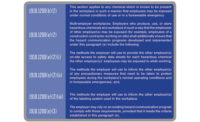The food and beverage industry relies heavily on supply chains—arguably more so than any other industry. Although outsourcing is necessary for leveraging specific skills or products and controlling costs, it also warrants a new set of business challenges.
It’s important to address and alleviate these challenges because failure to do so can result in serious product issues. One small quality issue in the food and beverage industry can lead to thousands of people getting sick. One single incident can have disastrous consequences and permanently affect the public’s trust in your brand.
The key to preventing quality issues is creating a culture of food safety. You can have this culture in your organization when each team member holds quality and safety as top priorities. This is easier to do within your internal team, but it is a little more challenging to extend to external suppliers.
By identifying and addressing the challenges that come with supply chain management and improvement, you can promote a food safety culture that extends beyond your four walls.
Challenges in the supply chain
Since supply chain challenges affect your operations and products, they indirectly affect the consumers of your products. Failure to overcome these challenges risks the health of your consumers. Here are some of the most pertinent challenges and how automated quality tracking systems help you overcome them and keep your consumers safe and healthy.
Security concerns: Collaborating with suppliers means including them in your operations, but that may put sensitive information at risk. However, overcorrecting by keeping suppliers completely separate from the rest of your processes doesn’t work either. Excluding suppliers completely makes collaboration more difficult and prevents you from maximizing the relationship. You would have to rely on outdated and inefficient communication methods like email to plan and execute quality assignments, rather than extending your current quality system to incorporate suppliers.
To overcome this challenge, you can use a system that features external assignments. They keep suppliers within your quality system yet only give them access to what they need to complete the assignment. Your confidential information is safe, but you can track quality data throughout your suppliers.
Response time: The more people you have involved in a quality task, the longer it takes to plan and execute. When you work with suppliers, there may be a delay while you wait for them to receive, respond to and complete assignments.
Too long of a delay, however, leaves quality issues undetected or unresolved for too long. For every minute that a quality issue goes unresolved in the food and beverage industry, dozens, hundreds or even thousands of people could get sick. Quick response time is critical for a food safety culture.
Using a system that supports notifications and reminders can drastically reduce response time. Important information won’t sit unread in an inbox. Reminders keep everyone on track with what they’re doing and promote a sense of urgency around quality tasks.
Accuracy of information: When information gets passed around from party to party, there’s a good chance it may get unintentionally altered from start to finish. Sometimes information is misread, misinterpreted or recorded incorrectly.
This may not seem like a big deal in everyday conversation, but in the food and beverage industry it can be catastrophic. The smallest inaccuracy gets magnified in proportion to the number of products produced. The slightest difference in data can cause thousands of products to be exposed to unsafe handling conditions, contaminants or allergens.
Automated quality tracking reduces human error, ensuring that your information is accurate. Having everything recorded and documented automatically lets you have confidence that your data is accurate and your consumers will be safe and trust in your brand.
Continuous improvement
In addition to alleviating supplier challenges, promoting continuous improvement is important to creating a food safety culture. Automated quality tracking systems provide the tools you need to work towards quality goals of continuous improvement and food safety culture.
Notifications and reminders: Not only do notifications and reminders decrease response time, they also increase accountability throughout the supply chain. Notifications keep assignments a top priority for suppliers and reminders hold them accountable for finishing their tasks in a timely manner. Together they promote an organization-wide priority of quality which leads to more efficient operations.
The benefits are twofold: you no longer have to spend a lot of time scheduling and following up on tasks, which frees up your time to dedicate to building public trust, investing in sustainability and developing better business practices.
Data and reporting: Automated quality tracking systems provide a platform to track, collect and analyze quality data. Having visibility into all operations lets you instantly see what is going on, what your strengths are and where you need to improve.
Having all quality data in a logical place lets everyone have conversations around the same quality data and in one central location. The data can then be exported and analyzed so it can be transformed into meaningful information. Then, it is ready to be a driving force behind decisions and changes that will lead to improvement.
When you’re constantly getting better, your products will be better and safer. Having a common goal of increased food safety engrains quality management into your organization’s culture.
Closing thoughts
Creating a food safety culture means making quality management a top priority throughout the entire organization. Often, this vision gets derailed because of the complications of supply chain management. Having an automated quality tracking system gives you the tools you need to alleviate these challenges, as well as continuously improve your food safety culture.






